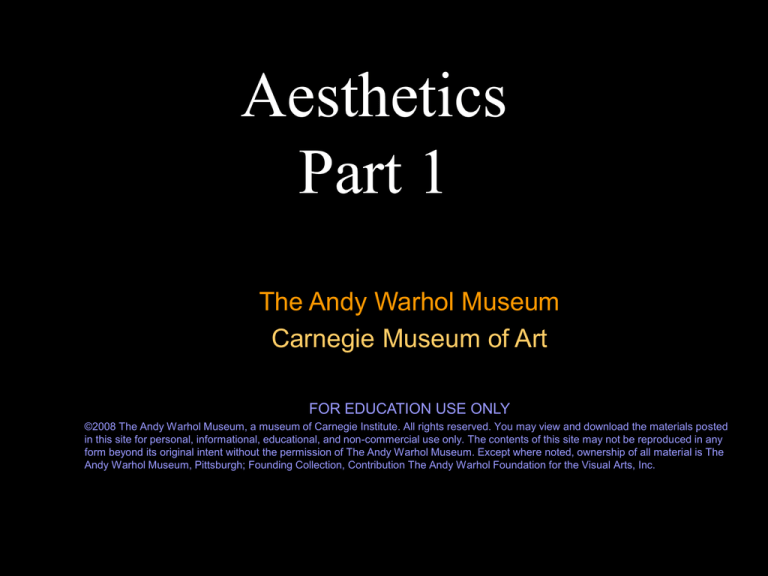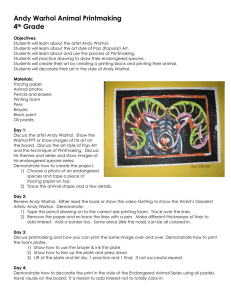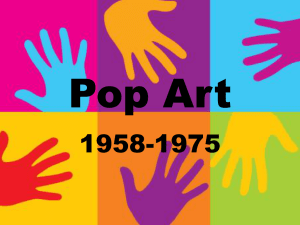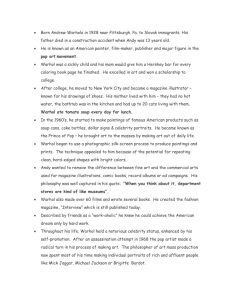
Aesthetics
Part 1
The Andy Warhol Museum
Carnegie Museum of Art
FOR EDUCATION USE ONLY
©2008 The Andy Warhol Museum, a museum of Carnegie Institute. All rights reserved. You may view and download the materials posted
in this site for personal, informational, educational, and non-commercial use only. The contents of this site may not be reproduced in any
form beyond its original intent without the permission of The Andy Warhol Museum. Except where noted, ownership of all material is The
Andy Warhol Museum, Pittsburgh; Founding Collection, Contribution The Andy Warhol Foundation for the Visual Arts, Inc.
Objectives:
• Develop and use a common language for
aesthetics.
• Increase knowledge of aesthetics in
meaning and in application.
• Analyze an artist’s motivation for making
aesthetic choices.
• Improve listening and reasoning skills
through group dialogue.
Vocabulary Check
Intuition
1.a. The act or faculty of knowing or sensing without the use
of rational processes: immediate cognition. b. Knowledge
gained by the use of this faculty; a perceptive insight.
2. A sense of something not evident or deducible; an
impression.
Perception
The word, perception, comes from the Latin word:
Capere - to take Per (the prefix) - ‘completely’
1.The process, act, or faculty of perceiving: OBSERVATION
2.The effect or product of perceiving: CONCEPT
3. Psychol. a. Recognition and interpretation of sensory stimuli
based chiefly on memory.
In psychology and the cognitive sciences, perception is the
process of acquiring, interpreting, selecting, and organizing
sensory information.
3 Definitions for Aesthetics:
1. a particular taste for, or approach to, what is
pleasing to the senses--especially sight;
2. a branch of philosophy dealing with the
nature of art and beauty;
3. a particular theory or conception of beauty
or art.
Definition one: Aesthetics
Function: noun
1. a particular taste for or
approach to what is
pleasing to the senses-especially sight.
Aesthetics in this definition is something that appeals to the
senses. Someone’s aesthetic has to do with his or her
perceptual or artistic judgment.
It comes from the root word:
Aesthesia: the ability to feel or
perceive; being awake and
able to feel senses.
The opposite is:
Anesthesia: the inability to feel
or perceive; to be asleep or
non-feeling.
We make informal
aesthetic choices every
day.
From what we wear . . .
to the things we
buy: books,
music, and
objects for our
homes.
Public figures make aesthetic
choices to convey something
about who they are.
Andy Warhol wore various
silver wigs throughout the
’60s, ’70s, and ’80s to change
his personal appearance--to
create a signature look.
Who does this in today’s
popular culture?
Andy Warhol, Self-Portrait (Fright Wig), 1986,
Polaroid™ Polacolor ER, 4 1/4 x 3 3/8 in. (10.8 x 8.6
cm.). ©AWF
The aesthetic choices we make influence many
parts of our lives.
We all have a personal aesthetic
(preferences and tastes based on what we see).
How would you
describe the aesthetic
quality of your
classroom at school?
How would you
describe the aesthetic
quality of your
bedroom?
What aesthetic qualities do
you perceive in this
photograph of Andy Warhol
in his Silver Factory?
Andy Warhol at the Silver Factory with Cow wallpaper and Silver
Clouds, 1965-1966, Photo ©Stephen Shore
Warhol used some of
the aesthetic qualities
of his environment in
his artwork.
Andy Warhol
Silver Liz Studio Type (1963). ©AWF
What are the
similarities between
this portrait and the
photograph in the
previous slide?
Aesthetics
Part 2
Th e A n d y Wa rh o l M u s e u m
C a rn e g ie M u s e u m o f A rt
F O R E D U C A T IO N U S E O N L Y
© 2008 The Andy Warhol Museum, a museum of Carnegie Institute. All rights reserved. You may view and download the materials posted in
this site for personal, informational, educational and non-commercial use only. The contents of this site may not be reproduced in any form
beyond its original intent without the permission of The Andy Warhol Museum. except where noted, ownership of all material is The Andy
Warhol Museum, Pittsburgh; Founding Collection, Contribution The Andy Warhol Foundation for the Visual Arts, Inc.
Definition Two: Aesthetics
Function: noun
2. A branch of philosophy dealing with the
nature of art and beauty.
The philosophy of aesthetics
asks and tries to answer the
“Big” Questions:
• What is art?
• What makes a piece of art beautiful?
• How important are personal tastes when judging
the quality of art?
• What are the standards for judging art?
• Why is originality so important in art? How do we
define what is original or what is creative?
The Nature of Beauty
Andy Warhol, Electric Chair, 1971, Published Edition, 137/250 screen print on paper, 35 1/2 x 48 in. ©AWF
Do artworks have to be beautiful or pretty?
What makes a work of art original or
creative?
Andy Warhol, Flowers, 1970, Published Edition, screen print on paper, 36 x
36 in. ©AWF
Original source material, Flowers series by Andy
Warhol, 1964, Two-sided collage; adapted from Modern
Photography magazine, June 1964, photographic spread
of color transparencies by Patricia Caulfield. ©AWF
If Warhol worked from other people’s photographs,
is his work really original? … Why does he get to copy, but I can’t?
Rembrandt Harmensz. van Rijn Self-Portrait with Raised
Sabre, 1634, etching with touches of burin, 4 7/8 x 4 1/16
in. (12 x 10 cm) Carnegie Museum of Art
Andy Warhol, Self-Portrait, 1986, acrylic and silkscreen ink
on linen, 80 x 76 in. ©AWF
How does an artist’s choice of materials and
techniques effect the aesthetic quality of an
artwork?
Who decides what is art?
Who decides what makes an
artwork special, valuable, or
good?
Andy Warhol, Brillo Soap Pads Box, 1964,
silkscreen ink and house paint on plywood,
17 x 17 x 14 in. ©AWF
Aesthetics Part 3
The Andy Warhol Museum
Carnegie Museum of Art
FOR EDUCATION USE ONLY
© 2008 The Andy Warhol Museum, a museum of Carnegie Institute. All rights reserved. You may view and download the materials posted
in this site for personal, informational, educational, and non-commercial use only. The contents of this site may not be reproduced in
any form beyond its original intent without the permission of The Andy Warhol Museum. Except where noted, ownership of all
material is The Andy Warhol Museum, Pittsburgh; Founding Collection, Contribution The Andy Warhol Foundation for the Visual
Arts, Inc.
Definition three
Aesthetics
Function: noun
3. A particular theory or conception of beauty
or art.
Aesthetic theories provide
different answers to these
questions:
What makes something a work of art?
What do we learn from it?
What value does this work have?
Aesthetic
Theories:
1. Representation (imitation, realism,
mimesis)
2. Expressionism (emotionalism)
3. Formalism
4. Communication of moral and religious
ideas
5. Symbolic (non-verbal) communication
6. Instrumentalism
7. Institutionalism
Material adapted from Julie Van Camp, Professor of Philosophy, California State University, Long
Beach, presentation Teaching Aesthetics. http://www.csulb.edu/~jvancamp/multi/index.html
This is a basic selection of theories. There are many
more to research and explore.
Representation
(imitation, realism,
mimesis):
The essence of art is to
picture or portray reality.
Good art mirrors the world,
imitating nature or some
ideal form.
Martin Johnson Heade,
Thunderstorm at the
Shore, c. 1870-1871, oil
on paper mounted on
canvas attached to panel
15 3/4 x 23 3/4 in.
Carnegie Museum of Art,
Howard N. Eavenson
Memorial Fund
Expressionism (emotionalism):
The essence of art is expression of
the inner emotions, feelings, moods,
and mental states of the artist. Good
art effectively and sincerely brings
these inner states to an external
objectification.
Willem de Kooning,
Woman VI, 1953
Oil on canvas
Formalism:
The essence of art is “significant
form” - lines, shapes, colors, and
other formal properties of the
work; representation, expression,
and other subject matter are
irrelevant. Good art uses formal
elements to trigger an “aesthetic
emotion” in sensitive observers.
Donald Judd, Untitled, 1974,
Stainless steel and Plexiglas
8 x 194 1/2 x 14 in. Carnegie Museum of Art,
Purchase: gift of Mr. and Mrs. Charles Denby, by
exchange
Communication of moral and
religious ideas:
The essence of art is the
communication of
important moral and
religious values from the
artist to the observer.
Good art is a form of
sincere communication
by the artist that
“infects” the observers
with those important
moral ideas.
Simon Bening, St. Gertrude de Nivelles, from the Hours of
Cardinal Albrecht of Brandenburg (1490-1545), Archbishop
and Elector of Mainz c. 1522-1523, opaque water-based paint
mounted on board 7 x 5 in. Carnegie Museum of Art, Bequest
of Howard A. Noble
Symbolic (non-verbal)
communication: The essence of art is the
communication of
important ideas and other
knowledge through
symbolic (non-verbal)
languages. Good art
communicates its meaning
effectively through this
non-verbal language.
Jacob Ochtervelt, Lady with Servant and Dog, c. 1671-1673,
oil on canvas, 27 1/8 x 22 7/8 in. Carnegie Museum of Art,
Henry Lee Mason Memorial Fund
Instrumentalism:
The essence of art is
its usefulness in
helping us to
comprehend and
improve our overall
life experiences.
Good art is always a
means to some
important end.
Romare Bearden, Pittsburgh Memories, 1984, collage on
board, 28 5/8 x 23 1/2 in. Carnegie Museum of Art, Gift of
Mr. and Mrs. Ronald R. Davenport and Mr. and Mrs. Milton
A. Washington
Institutionalism:
Andy Warhol, Brillo
Soap Pads Box,
1964, silkscreen ink
and house paint on
plywood, 17 x 17 x
14 in. ©AWF
Art is determined by
status conferred upon it
by the institutions of the
art world not by an
observable property in
the artwork itself.
Barry Le Va, On Corner - On
Edge - On Center Shatter
(Within the Series of Layered
Pattern Acts), 1968-1971,
twenty sheets of glass 59 x 79
in. ( 91 x 150 x 201 cm)
Carnegie Mellon Art Gallery
Fund
Review
3 definitions for aesthetics:
1. a particular taste for, or approach to, what is pleasing
to the senses--especially sight;
2. a branch of philosophy dealing with the nature of art
and beauty;
3. a particular theory or conception of beauty or art.






